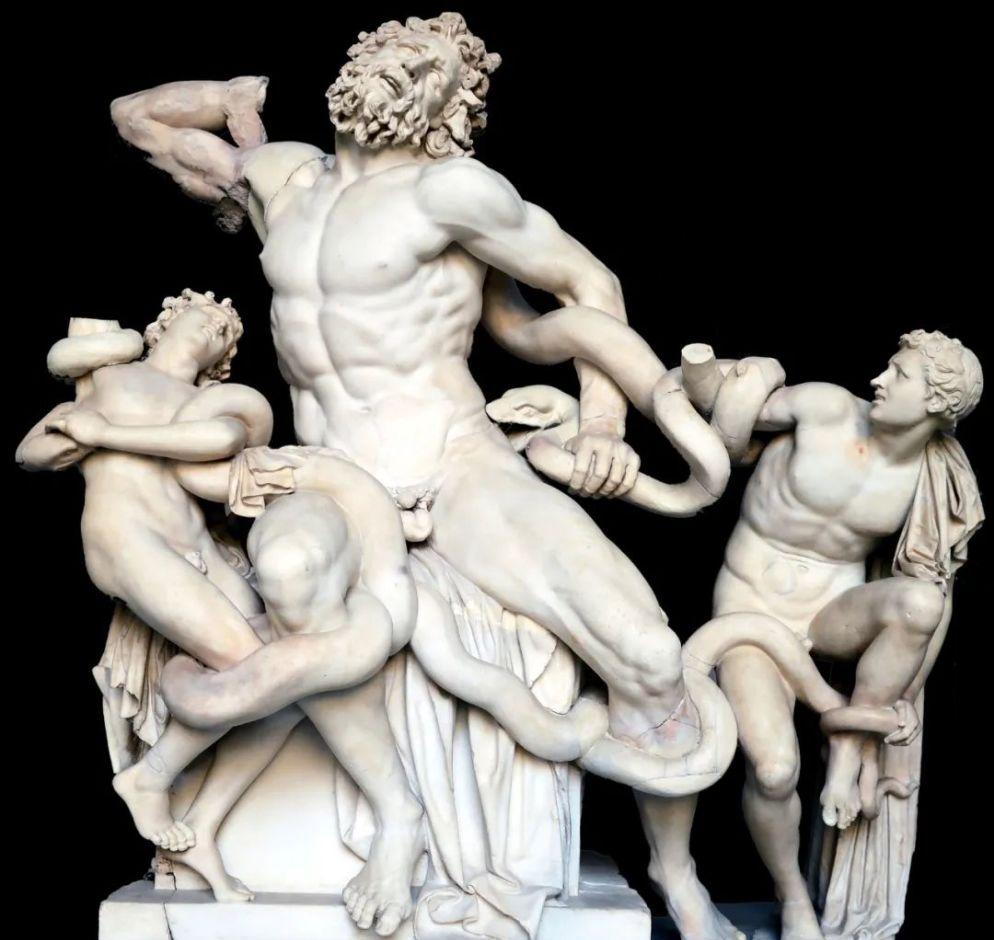Jing Du Jun: Laocon is not so much portrayed as a hero as a victim of a giant python, which metaphorically refers to the "noose of destiny" that becomes tighter and tighter the more it resists.
In the Courtyard of Belvedere in the Vatican Museums, a marble sculpture called "Laocoön and his sub-group portraits" stands, only to see a strong, bearded man struggling with the python at his waist, not only for his own life, but also for the two terrified teenagers around him, who are his sons.

▲ Marble group sculpture "Laokorn and its sub-group portraits"
(Ancient Rome, c. 1st century BC to 2nd century AD)
By three artists, including Argyndros from Rhode Island
It is now in the Collection of the Vatican Museums
Laocoön was a high priest in the ancient kingdom of Troy three thousand years ago. At that time, Troy was a prosperous country developed and prosperous due to geographical advantages, and the richest land on the Mediterranean coast was targeted by greedy and barbaric Greeks, so the Trojan War of the Greek coalition invaded Troy broke out. The famous "Trojan Horse Scheme" in the history of Western warfare took place in this war, and Raocon was the Trojan prophet who saw through the tricks of the Greeks, but was executed by the Greek gods Athena, Apollo, and Poseidon, who sent down pythons for leaking the heavenly opportunity. Sadly, the stupid Trojans did not believe Laocoön's warning prophecy that they would march the Greeks into the city and eventually slaughter it.
▲ Oil painting "Trojan Horse" (1874)
By the French historical painter Henri-Paul Mott
It is now in the collection of the Cocoran Museum of Art in Washington, D.C
The marble sculpture Laocoön and His Descendants, now in the Vatican Museums, depicts the gods descending on a python to attack Laocoön and his sons. Gaius Plinius Secundus (23-79), a famous Roman naturalist who died from observing the eruption of Mount Vesuvius up close, mentioned the sculpture in his own book and praised it.
▲ Oil painting "Discovery of Laocoön" (1773)
French Romantic academic painter
H. Robert Robert, 1733-1808)
It is now in the collection of the Virginia Museum of Fine Arts
Later, the sculpture was buried by the smoke and dust of history, and it was not until 1506 that it was rediscovered in the vineyards of the ruins of the Golden Palace of Eskillenelli in Rome. As a result, art historians mostly believe that Laocoön and his sub-portraits used to be works of art belonging to Nero (37-68).
▲ Oil painting "Nero in Baya" (c. 1900)
Polish painter J. Steka Styka, 1858-1925).
Private collections
After the discovery of Laocoön and his sub-portraits in 1506, Pope Julius II, who loved art collecting, was found to be a man of art. II, 1443-1513) immediately took possession of it and placed it in the Belvedere Courtyard of the Vatican. For renaissance people who had just begun to be enthusiastic about antiquities collection, the discovery of the ancient Roman sculpture "Laocoön and its sub-portraits" was a sensation, and many works of art with it as the object of creation appeared.
▲ Copperplate engraving Laocoön (1520-1525)
By the Italian Renaissance printmaker Mark Dante
It is now in the collection of ETH Zurich
For example, on the copperplate engraving Laocoön by the Italian Renaissance printmaker Marco Dente (circa 1486-1527), we can see that the "Belvedere" (Belvedere) is engraved on the pedestal where the sculpture is placed, indicating that the sculpture was placed in the Vatican at that time; at the same time, behind the sculpture is a ruin of ancient Roman ruins, showing the site of the sculpture's discovery, the site of the Niro Golden Palace, both of which highlight the monumental significance of the sculpture. The brushstroke lines in the shadow parts of the prints further enhance the sense of dynamics, forming a powerful temporal and spatial reproduction of this ancient Roman artwork. The copperplate engraving was popular on the European art market at the time. So why is Laocon missing an arm in Dante's engravings? See below.